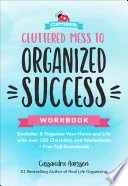

The first step in organizing your life is to understand what clutter truly is. Clutter isn't just physical mess; it encompasses emotional, mental, and digital clutter as well. The workbook encourages readers to identify different types of clutter in their lives and how they impact productivity and mental well-being. By recognizing clutter, individuals can begin to take actionable steps towards decluttering their environments. This understanding is crucial because it sets the foundation for all subsequent organizing efforts. Readers are guided through exercises that help them assess their current state, identify sources of clutter, and understand the emotional connections they have with their possessions. This self-awareness is vital for making informed decisions about what to keep, what to let go, and how to create a more organized space that promotes success.
Continue readingThe workbook emphasizes the importance of setting clear, achievable goals as a precursor to effective organization. It guides readers through the process of defining what success looks like for them personally and professionally. By setting specific, measurable, attainable, relevant, and time-bound (SMART) goals, individuals can create a roadmap for their organizational efforts. This section of the workbook includes practical exercises to help readers articulate their goals and prioritize them based on urgency and importance. The act of goal-setting not only provides direction but also serves as motivation to tackle the clutter. Readers learn that having a clear vision of their objectives can significantly enhance their focus and commitment to the organizing process.
Continue readingOnce goals are established, the next step is to create a comprehensive action plan. The workbook provides a structured approach to breaking down larger goals into smaller, manageable tasks. This segmentation is essential for preventing overwhelm and ensuring steady progress. Readers are encouraged to develop timelines and checklists to track their efforts. The workbook also highlights the importance of flexibility in the action plan, allowing for adjustments as necessary. By creating an actionable roadmap, individuals can maintain momentum, celebrate small victories, and ultimately achieve the larger goal of a more organized life. This systematic approach is critical for sustaining motivation and fostering a sense of accomplishment.
Continue readingDecluttering is a core focus of the workbook, and it provides various techniques to help individuals effectively reduce clutter. From the 'Four-Box Method' (keep, donate, trash, and relocate) to the '30-Day Declutter Challenge', readers are equipped with practical strategies to tackle their mess. The workbook encourages readers to start small, perhaps with a single drawer or room, to build confidence and experience immediate results. It also emphasizes the importance of regular decluttering sessions to maintain an organized environment. The techniques presented are designed to be customizable, allowing readers to find what works best for their unique situations. This hands-on approach empowers individuals to take control of their spaces and create lasting change.
Continue readingAfter decluttering, establishing organizational systems is crucial for maintaining order. The workbook discusses various organizational methods, such as the use of labels, storage solutions, and digital organization tools. Readers learn how to categorize items effectively and create designated spaces for everything in their home or workspace. The workbook also delves into the psychology of organization, explaining how a well-organized environment can enhance focus, creativity, and productivity. By implementing these systems, individuals can ensure that their spaces remain clutter-free and conducive to success. This section provides practical tips and examples, making it easy for readers to visualize and implement organizational changes.
Continue readingThe final key idea focuses on the importance of maintaining organization over time. The workbook stresses that organization is not a one-time event but an ongoing process. It offers strategies for regular maintenance, such as setting aside time each week for tidying up and reassessing organizational systems. Readers are encouraged to develop habits that promote cleanliness and order, such as the 'one in, one out' rule for new items. This section also addresses common challenges to maintaining organization, such as life changes or unexpected events, and provides solutions for overcoming these obstacles. By fostering a mindset of continuous improvement, individuals can ensure that their organized spaces remain functional and supportive of their goals.
Continue readingThe workbook concludes with a discussion on the importance of mindset and motivation in the organizing journey. It encourages readers to cultivate a positive attitude towards organization and to view it as a means of enhancing their quality of life. The workbook includes motivational exercises and affirmations to help individuals stay focused on their goals. By addressing the psychological barriers that often accompany clutter, such as fear of letting go or perfectionism, readers are empowered to move forward with confidence. This emphasis on mindset reinforces the idea that organization is not just about physical spaces; it’s about creating a lifestyle that promotes success and well-being.
Continue reading